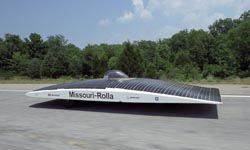Stampede to Calgary: Stampede to Calgary: UMR solar racers start title defense in Austin
Posted by news
On a quest to soak up more solar glory, a team of University of Missouri-Rolla students is preparing to leave for Austin, Texas, where the North American Solar Challenge starts July 17.
UMR’s vehicle, “Solar Miner V,” has some big cells to fill, so to speak. Its predecessor, Solar Miner IV, won the 2003 American Solar Challenge, a 2,300 mile race from Chicago to Los Angeles along historic U.S. Route 66.
Every two years, teams from colleges and universities in the United States and Canada compete in a cross-country – or in this case, cross-countries – solar race. The UMR team, which builds a new car for each solar challenge, is looking to win its third championship. If everything goes as planned, they will cross the finish line in Calgary, Alberta, on July 27.
 |
| Solar Miner V is headed to Austin, Texas, where the North American Solar Challenge starts July 17. |
“The car is always evolving,” says Stephanie Maiden, team president and veteran solar car racer. “We look at what worked great, and try to make it even better.”
Equipped with a stronger chassis and more expensive cells, Solar Miner V will travel north through Texas, Oklahoma, Kansas, Nebraska, South Dakota and North Dakota. After crossing the border and arriving in Winnipeg, Manitoba, the team will turn the three-wheeled car west and cross three Canadian provinces on the way to Calgary.
From start to finish, the North American Solar Challenge is 2,500 miles long, the longest solar car race ever. Forty-one teams are expected to participate.
Each team has several drivers who take the controls at various times during the race, and they don’t have an easy job. The cars are cramped and hot. The drivers must race for hours in a prone position. They have to work levers to steer the vehicles, while on the lookout for gas-guzzling trucks, buses, mini-vans, sports utilities and “regular” cars. And there could always be a turtle trying to cross the road.
“I think the turtle incident happened to Solar Miner III,” says Dan Riley, the 2005 team’s vice president for manufacturing. “The driver tried to straddle a turtle in the middle of the road with his two front tires, like you would in a regular car. But he forgot the solar car only had one wheel in the back, right in the center.”
It’s not clear what happened to the turtle. It is clear that UMR is trying to build something of a dynasty when it comes to solar car racing.
As defending champions, UMR’s strategy for this race has been simple. Make an even better car than Solar Miner IV, and drive it as smart as possible. Solar Miner IV beat the previous record time – by the University of Michigan team in 2001 – by nearly five hours. In 2003, the University of Minnesota finished a distant second to UMR.
“This car handles better,” says Chris Pieper, a senior on the 2005 team who also drove in the last race. “It’s relatively comfortable – still terribly uncomfortable, actually, but there’s more room.”
And if Solar Miner V hits a pothole or runs over a turtle, the team is confident the car won’t crack. One of the only problems the team had in 2003 was a troublesome chassis that had to be welded several times after cracking during the race. The new chassis was designed stronger; although, at about 550 pounds (including the driver), the 2005 car is still considered very light.
The new car cost $165,000, up from $100,000 in 2003. The increase can be attributed mainly to better, more expensive solar cells. “These are space grade cells,” says Riley. “They convert a higher percentage of the sun’s energy into electrical energy.
The amount of energy required to run the car for long periods at the speed limit is approximately the amount of energy it takes to power “one-and-a-half hair dryers,” according to Riley.
A lead car and van accompany the solar vehicles. The UMR team anticipates covering about 200 miles per day.